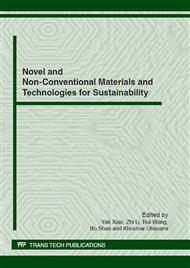[1]
A Elremaily, A Azizinamini. Experimental behavior of steel beam to CFT column connections. Journal of Constructional Steel Research, Vol 57(10), ( 2001), p.1099.
DOI: 10.1016/s0143-974x(01)00025-6
Google Scholar
[2]
WD Wang, LH Han, B Uy. Experimental Behaviour of Steel Reduced Beam Section (RBS) to Concrete-Filled CHS Column Connections. Journal of Constructional Steel Research, Vol 64(5), (2008) , p.493.
DOI: 10.1016/j.jcsr.2007.10.005
Google Scholar
[3]
XL Lv, XP Li. Experimental study on ring beam connections located outside the concrete filled rectangular steel tubular columns. Journal of Building Structures. Vol 24(1), (2003), pp.7-13.
Google Scholar
[4]
H Qu. Behaviours and calculations on the beam-column connections of concrete-filled steel tubular column structures. Fuzhou: Fuzhou University, (2007). (in Chinese).
Google Scholar
[5]
Y C Ou, M Chiewanichakorn, I S Ahn, et al. Cyclic performance of precast concrete segmental bridge columns. TRB 2006 Annual Meeting CD-ROM, (2006).
Google Scholar
[6]
ZJ Li, T Balendra, KH Tan, KH Kong. Finite element modeling of cyclic behavior of shear wall structure retrofitted using GFRP. ACI Special Publication, Vol 2(230), (2005), p.1350.
DOI: 10.14359/14895
Google Scholar
[7]
C Xu. Research on the seismic and fire resistance behaviour of square concrete-filled thin-walled steel tubular columns with longitudinal stiffeners, Doctoral engineering thesis, Harbin Institute of Technology, (2007), (in Chinese).
Google Scholar
[8]
LH Han, G. H Yao, Z Tao. Performance of concrete-filled thin-walled steel tubes under pure torsion, Thin-Walled Structures, Vol. 45(1), (2007), p.24.
DOI: 10.1016/j.tws.2007.01.008
Google Scholar
[9]
MM Attard, S Setunge. Stress-strain relationship of confined and unconfined concrete, ACI Materials Journal, Vol. 93(5), (1996), p.432.
DOI: 10.14359/9847
Google Scholar
[10]
JM Shen, CZ Wang, JJ Jiang. Finite element analysis of RC and limit analysis of shell, Tsinghua university press, Beijing. (1993).
Google Scholar
[11]
J Lubliner, J Oliver, S Oller, E Onate. A plastic-damage model for concrete. Int. J. Solids Struct, Vol. 25(3), (1989), p.299.
DOI: 10.1016/0020-7683(89)90050-4
Google Scholar
[12]
J Lee, GL Fenves. Plastic-damage model for cyclic loading of concrete structures, Journal of Engineering Mechanics, Vol. 124(8), (1998), p.892.
DOI: 10.1061/(asce)0733-9399(1998)124:8(892)
Google Scholar
[13]
WB Krätzig, R Pölling. An elasto-plastic damage model for reinforced concrete with minimum number of material parameters, Computers and Structures, Vol. 82 (2004), (2004), p.1201.
DOI: 10.1016/j.compstruc.2004.03.002
Google Scholar
[14]
V Birtel, P Mark. Parameterised finite element modelling of RC beam shear failure, 2006 ABAQUS Users' Conference, (2006), p.95.
Google Scholar
[15]
V S Gopalaratnam, S P Shah. Softening response of plain concrete in direct tension. ACI J, Vol 82(3), (1985), p.310.
Google Scholar
[16]
BP Sinha, KH Gerstle, LG Tulin. Stress–strain relations for concrete under cyclic loading. ACI J, Vol 61(1964), (1964), p.195.
DOI: 10.14359/7775
Google Scholar


